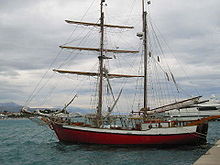Brigantine (ship type)

A brigantine (schoonerbrigg) is a sailing ship with two masts, the front of which is referred to as the foremast , the rear as the main mast . At the foremast a brigantine leads square sails ; on the mainmast, she partly or exclusively wields jib sails .
The brigantine is therefore a hybrid of brig and schooner . With its square sails it can make better use of the wind from behind ( clear wind) than a schooner; In addition, thanks to its sloping sails , it can sail higher upwind than a brig, which means that it can sail “diagonally against the wind” better.
Brigantine subtypes
Depending on the rigging , different types of sailing ships are distinguished, which today are collectively referred to as brigantine.
Schooner brig or half brig
The schooner brig, also known as the half brig, only wields bail sails on the main mast; this can either be a gaff sail with a topsail if necessary, or a triangular Bermuda sail .
Bulky cargo sailors rigged as schooner briggs already existed in Holland in the 17th century. By the middle of the 19th century, numerous schooner briggs with 100 to 300 GRT were built in Europe and North America. A modern representative of this type of ship is the built in GDR times German brigantine Greif (formerly Wilhelm Pieck ) or 1968 Rhodes built and sunk in August 2013 German schooner Falado of Rhodes .
Brigantine or three-quarter brig
The type, usually referred to simply as a brigantine, has a gaff sail on the main mast and further square sails above it.
Grippa or Grippo
The type of ship known as Grippa (or Grippo in Italian , Gripe in French ) from the 15th and 16th centuries is often only described as a type of brigantine.
According to Dudszus, these ships were around 17 meters long and up to four meters wide, and were used for fishing and transporting loads in the northern Mediterranean , some of them armed. The Gripparia , which was even smaller than a Fusta , may have been derived from the Grippa ship type, originally from Venice .
Previous meaning of the word
Originally, a brigantine was understood to mean a smaller sailing warship that could also be rowed. The sails consisted of latin sails . The bow and stern were raised compared to the galleys , so that this type of ship had an advantage in terms of defense and was also more seaworthy. This type was widespread from the 16th century, especially in the Mediterranean region.
At the end of the 17th century, the name was transferred to two-masted, frame-rigged sailing ships in north-western Europe. The current meaning of the word brigantine began in the 19th century.
See also
Web links
Individual evidence
- ↑ a b Dudszus, Alfred: The great book of ship types - Vol. 1: Ships, boats, rafts under oars and sails . Berlin (Transpress), licensed edition Stuttgart (Pietsch) 1990, ISBN 3-613-50058-2 , p. 67
- ^ Entry on Grippo / Gripe : "Sorta di Brigantino da costeggiare, ch'era in uso altrevolte." In: GF Barberi (ed.): Dizionario Italiano-Francese . Paris 1839, p. 565.
- ↑ Auguste Jal: Archeology navale . Bertrand, Paris 1840, p. 133.
- ↑ Alfred Dudszus: The great book of ship types: Ships, boats, rafts under oars and sails, steamships, motor ships, marine technology. Pietsch Verlag, Stuttgart 2004, ISBN 3-613-50391-3 , p. 133
- ↑ Nicholas Coureas: From the Middle Ages to the Renaissance: Elements of Transition in the Chronicles of George Boustronios : In: Erik Kooper (ed.): The Medieval Chronicle VI . Rodopi, Amsterdam 2009, ISBN 904202674X , p. 194

